MILLING-GRINDING-DRILLING AND SLOTTING ATTACHMENT (VERSA-M I L)
The milling-grinding-drilling and slotting attachment is commonly referred to as a Versa-Mil. It is a compact, portable unit capable of doing many machining operations that normally require expensive single-purpose machines. With the different attachments that are available with the unit, drilling, shaping, milling, and grinding can be performed quickly and inexpensively. This self-powered, vertical-feed, variable-speed precision tool may be mounted in any position on the carriage, table, ram, turret, or tool arm of other machine tools. With a two-directional feed table, the Versa-Mil unit becomes a complete machining tool for bench or inplace machining of parts too large to be moved or held in conventional machine tools.
An important factor in the efficiency of the Versa-Mil is that machine tools already in the shop area provide the power for feeds, a means of holding and moving the work, and the rigidity needed for machining. Faced with unusual machining problems, the Versa-Mil offers many solutions either as a separate tool or combined with other machine tools and machinery already in the shop to create special machines. The Versa-Mil increases the capabilities of standard machines by doing secondary operations without changing setups. The Versa-Mil provides power to interchangeable attachments allowing the unit to be used on site to perform different machining operations on equipment being repaired or rebuilt. Where space is limited, as in a shop area, floor space is needed only for the lathe. Different sizes of the Versa-Mil unit are available for light, medium, and heavy machining. This chapter will be limited to the Series 31 (light machining unit).
Safety in the shop area or around power equipment cannot be overemphasized. Each piece of equipment has safety procedures unique to that particular piece of equipment. Listed below are safety procedures that pertain to the Versa-Mil.
The Versa-Mil basic unit (Figure 9-1) has a powered machining head which moves vertically on four hardened ground guide posts by means of a precision-ground lead screw calibrated to 0.001 inch. Thirteen different speeds are available to the head through the use of different size pulleys to accommodate all types of machining and cutter sizes within the range of the unit. The circular T-slot on the face of the basic unit accommodates a variety of attachments. The graduation marks on the basic unit indicate the degree angle an attachment is to be positioned for various machining operations.
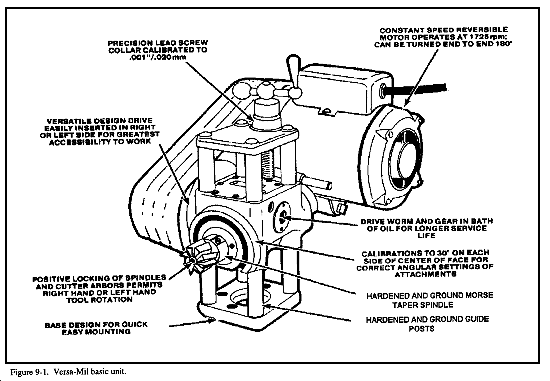
External Grinding Attachment
The external grinding head (Figure 9-2) bolts to the face of the Versa-Mil making the unit a precision external grinder. The head adjusts to 30 degrees range of angle to either side. A flat belt from the motor provides power to the head for smooth operation. Different pulley diameters allow matching spindle speeds to the grinding wheel size and rating. A wheel guard on the head offers protection to the operator from debris coming off the wheel during grinding.
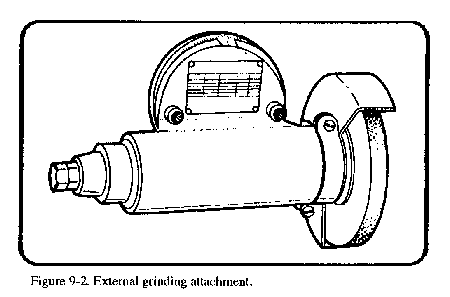
Internal Grinding Attachment
A wide variety of internal grinding jobs can be handled on a lathe with the Versa-Mil basic unit and the internal grinding unit (Figure 9-3). The internal grinding attachment bolts to the face of the basic unit and is driven by a flat belt from the motor. The internal grinder handles grinding wheels from 5/8 inch to 2 1/2 inches in diameter and grinds to a depth of 4 inches. Five different speeds are available to match the spindle speed to the grinding wheel diameter and rating.

Heavy-Duty Deep-Hole Grinder
The heavy-duty deep-hole grinder (Figure 9-4) may be attached to the face of the Versa-Mil for deep internal grinding. The deep-hole grinder accommodates grinding wheels 3 to 5 inches in diameter and grinds to a depth of 10 inches. A flat belt from the motor drives the deep-hole grinder for smooth operation. Six spindle speeds are available to match the spindle speed to the grinding wheel diameter and rating.
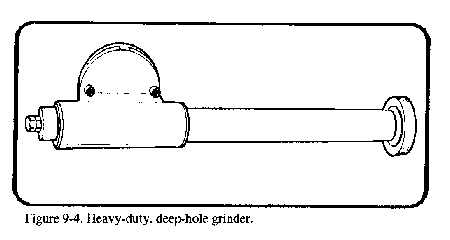
Tooth Stop Rest
Cutters held in the lathe chuck, collet, or between lathe centers can be ground quickly and accurately with the Versa-Mil unit equipped with an external or internal grinding head. The tooth stop rest (Figure 9-5) assures uniform grinding of cutter teeth because the finger on the gage ratchets over the teeth stopping each tooth in the exact same position. The tooth stop rest is completely adjustable for height and position.
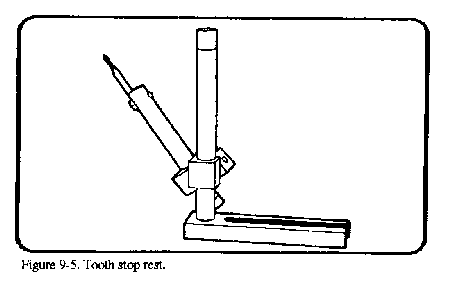
Diamond Dresser
The diamond dresser (Figure 9-6) is used with all Versa-Mil grinding attachments and clamps to the workpiece, tailstock, or lathe face plate to true the grinding wheel. A 0.35-karat industrial diamond mounts in either of two positions to dress the face or side of the grinding wheel. The cast-iron frame with V-notch clamps securely to round shapes up to 3 1/2 inches in diameter.
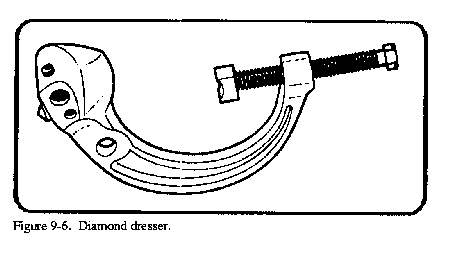
Universal Milling Head
The universal milling head (Figure 9-7) mounts to the face of the Versa-Mil and is driven by the spindle of the basic unit. This feature eliminates the need for special belts and permits the head to operate at any angle. The milling head and the basic unit have the same spindle taper and use the same arbors. With the universal head, machining can be performed along the side of the work, allowing the machining of much larger parts. Angular operations such as thread milling can easily be performed on large diameter material using the universal head.

Internal Keyseater and Slotter
This unit bolts to the face of the Versa-Mil and is driven by the basic unit spindle. The An internal keyseater and slotter (Figure 9-8) commonly called a "Versa-Shaper," bolts to the face of the Versa-Mil Versa-Shaper operates in any angular position and in either direction of stroke for cutting internal keyways, slotting, or shaping. Thestroke length adjusts from 0 to 4 inches with a speed of 44 to 450 strokes per minute. Tool holders for l/8", 3/16", 1/4", 5/16", and 1/2" cutters are available for use in the Versa-Shaper.

For speeds higher than the basic unit can provide, a high-speed end milling and drilling head (Figure 9-9) bolts to the face of the Versa-Mil. The head rotates 30° in either direction from center. Graduation marks on the face of the basic unit indicate the angle setting. Thirteen spindle speeds are available to the head directly from the motor through the use of a V-belt and pulleys. Arbors may be mounted in either end of the high-speed head. The spindle taper is the same as the basic unit. The high-speed head is used mostly for small diameter work such as end milling, drilling, or other related operations.

Indexing Head
The indexing head (Figure 9-10) mounts in the lathe head stock spindle to index work held in the lathe chuck, collet, or between lathe centers. The indexing head mandrel locks into a 1 1/8-inch or larger spindle bore; however, adapters for other bores are available. Forty turns of the dividing head crank rotates the lathe spindle one revolution. The indexing plate has 18 circles of holes allowing for divisions to be made in degrees, number of sides, or the number of teeth on gears or splines.

T-Slot Mounting Adapter
Versa-Mil units are furnished with an adapter (Figure 9-11) that fits the T-slot of the compound rest on most conventional lathes to lock the Versa-Mil unit to the compound rest with two hex-head bolts. Four holes in the base of the Versa-Mil unit allow mounting the basic unit in any of four positions 90° apart. Mounting the basic unit by this method permits the use of the compound rest for angular movement where low mounting of the Versa-Mil is not required. Any operation normally done above the centerline of the workpiece is usually accomplished by using the T-slot adapter and the compound rest. Such operations include milling keyways, slots, and splines, angle milling, and gear cutting. Other operations such as drilling or boring may also be accomplished if they are performed above the center line of the work.

Adapter Base Mounting
When a lower mounting of the Versa-Mil unit is required, the compound rest can be removed and replaced with a special adapter base (Figure 9-12) that mounts directly on the cross-slide. The base plates are semifinished and may require drilling two mounting bolt holes and a pivot pin hole. The location of these holes depends upon the lathe model and size. The base plate adapter should be used for operations on or below the centerline of the workpiece. Such operations include milling keyways along the side of a shaft, surface milling with a shell end mill, and drilling or boring on the centerline of the workpiece. The compound rest must be removed prior to mounting the base plate adapter.

Although not part of the basic unit accessories, the feed table may be found in some shop sets. Rigid accurate feed tables (Figure 9-13) make the Versa-Mil unit a portable machine tool by providing two additional directions of. travel. Precision finished ways, adjustable gibs, and accurate lead screws calibrated to 0.001 inch assure accurate positioning and feed for the most precise machining. Feed tables for Versa-Mil units are available in four different models and all feed tables can be quickly converted to reduce table height when only one direction of travel is required.
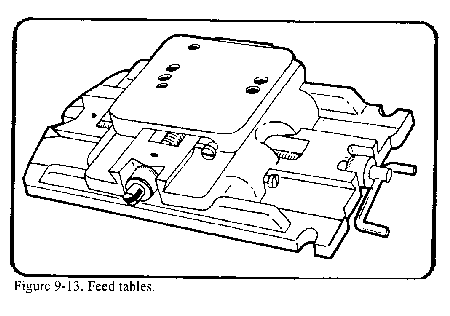
Machining done on the lathe with a Versa-Mil allows the cutter to move along three different axes: vertical, lateral, and longitudinal (x, y, z). However, not all machining can be done using the lathe. Because the lathe allows longitudinal and lateral movement, mounting the Versa-Mil directly to a bench or piece of equipment would severely restrict its machining capabilities. Feed tables eliminate that restriction by providing those two additional directions of travel. Feed tables mounted directly to a bench or piece of equipment allow the Versa-Mil to perform machining in all three directions.
When the basic unit is to be used independently or with an attachment other than the grinding attachments, an arbor and cutter must be selected and mounted. The cutter should be mounted onto the arbor first. The arbor should be secured in a vise to properly mount the cutter.
This ensures a properly torqued cutter and prevents the arbor from bending or causing damage to the Versa-Mil basic unit. When tightening the arbor nut, the pressure applied to the wrench should always be in the direction of the operator in case of slippage. Listed in the following paragraphs are various arbor styles and some of their uses. Note that they are similar to, but smaller than those used on a milling machine. Refer to chapter 8 for illustrations not listed.
Taper Arbors
Taper arbors (Figure 9-14) are designed primarily for use with Brown and Sharpe, or Morse standard taper shank tools.

Fly-Cutting Arbor
The fly-cutting arbor may be used for boring, facing, gear repair, keyway milling, and form milling. This type of arbor allows the tool bit to be positioned at either 45° or 90° to the arbor axis.
Side-Milling Arbor
The side-milling arbor (Figure 9-15) is used with arbor-type cutters and slitting saws. This arbor is supplied with 1/8" and 3/8" spacing collars.

Shell End Mill Arbor
The shell end milling arbor is used primarily for facing; however, milling a wide slot with a shell end mill can be accomplished.
Geared Chuck Arbor
This type of arbor is used for mounting chucks with a #3 Jacobs taper. The chuck itself is used primarily for drilling.
Straight Shank Arbor
The straight shank arbor with setscrews is used with straight shank drills of the correct size, end mills, and Woodruff key seat cutters.

Straddle Mill Arbor
The straddle mill arbor is used for milling splines on a shaft, milling hexagon or square shapes, and large keyways. Six spacers come with the Versa-Mil accessories, allowing milling of areas from 1/8 to 3 inches wide in 1/16 inch increments.
Threaded Angle Mill Arbor
The threaded angle mill arbor is used for milling angular grooves and dovetails.
After selecting the arbor, select the desired cutter for the machining process, mount the cutter on or in the arbor, and mount the arbor in the Versa-Mil unit or attachment. Ensure the arbor and spindle are free of dirt and burrs.
Woodruff Key Slot Cutters
This cutter has a l/2-inch straight shank and is used for cutting Woodruff keyslots in a shaft. This cutter may also be used for cutting straight keyways in a shaft or similar operations.
Side Cutters
Side cutters are available in two basic styles. The stagger tooth side milling cutter should be selected for milling keyways and deeply milled slots, while the straight side milling cutters are usually used in matched sets for straddle milling or individually for side milling.
Shell End Mill Cutter
This cutter is used for slabbing or surfacing cuts and end or face milling.
Form Cutters
Form cutters are manufactured in a variety of shapes. Selection of the cutter depends upon the desired shape or form to be machined.
Fly Cutters
Fly cutters are usually square tool bits ground with the proper clearances for boring, facing, or counterboring. Fly cutters can also be ground to particular shapes for special jobs such as gear repair or spline milling.
End mills are manufactured in a variety of shapes and styles and should be selected in accordance with the job to be performed. The two fluted end mills are recommended for cutting keyways and for deep milling while the multiple flute end mills are designed for end milling and routing work.
Slitting saws are manufactured in a variety of styles and sizes and should be selected in accordance with the job to be performed. Use slitting saws to cut deep slots in the work and for cutting slots.
When the external grinding head, internal grinding head, or deep-hole grinding head is selected and mounted on the Versa-Mil, a wide range of grinding operations is made available. The data books published by the leading abrasive manufactures should be referred to for proper selection of grinding wheels as the variety of grinding done by Versa-Mil is to great for complete coverage of wheels in this manual.
WARNINGUse only abrasive wheels designed for the external or internal grinding heads that have been tested and found to be safe when operating at the speeds attained by these heads. Using incorrect untested wheels may result in breaking the abrasive wheel causing wheel fragments to be projected into the work area endangering personnel and equipment. |
Straight Abrasive Wheels
Straight abrasive wheels are furnished in 46 and 60 grit sizes. The 46 grit wheel is a general-purpose wheel and should be selected for rough-grinding cylindrical parts, face plate grinding, and so forth. Select the 60 grit wheel for finishing and for tool and cutter grinding where finer finishes are required.
Straight Cup Wheels
Select a straight cup wheel should be selected for tool and cutter grinding, face plate grinding, and internal grinding of large holes.
Flare Cup Wheels
Select a flare cup wheel for general tool and cutter grinding.
Dish Wheels
Select a dish wheel for tool and cutter grinding such as grinding flutes and individual teeth of milling cutters.
The Versa-Mil adds important machining functions to a lathe. With built-in power and vertical feed, it adds a third machining dimension, allowing the operator to mill, drill, bore, slot, shape, grind, and perform other special operations. The success of any Versa-Mil operation depends largely upon the judgment of the operator in setting up the Versa-Mil, selecting the proper cutter, and holding the cutter by the best means possible under the circumstances.
Preoperational Checks
Gibs should be as snug as possible and still allow the movement needed. Tighten all gibs not required for the operation being done to prevent movement and chatter. The adjusting bar on the back of the lathe carriage that holds the carriage onto the lathe bed should be snug enough to still allow a slight drag when feeding the lathe carriage. If the work is held between centers, they should be tight against the work and long pieces should be supported at the point where machining is being done. Unless both the Versa-Mil and the work are rigidly supported, it is difficult to obtain accurate results.
Mounting on a Lathe
The Versa-Mil may be mounted on the front or the rear of the lathe carriage. On the front, it may be set on the compound rest or directly on the cross slide. A more permanent and generally more useful mounting is at the rear of the lathe carriage, where it may be left until it is needed.
Squaring the Versa-Mil to the Lathe
For accurate milling cuts, it is necessary to square the Versa-Mil to the lathe (Figure 9-17). The front compound face of the Versa-Mil is a reference surface machined in relation to the spindle. A square can be set across this face and squared to the chuck or face plate of the lathe. For work between centers, the Versa-Mil can be squared to the workpiece. After the machine has been squared on the compound rest of the lathe, the compound rest can be loosened for adjusting the spindle to various angles using the graduated scale on the compound rest. For extremely precise adjustments and settings, use the dial indicator or vernier protractor.
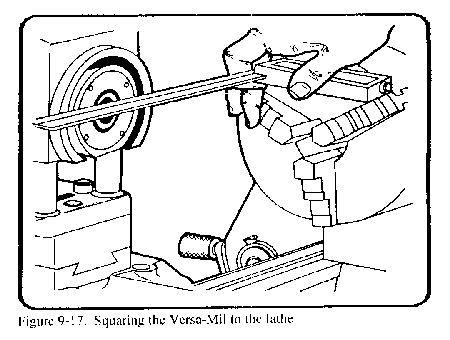
Conventional milling is recommended when using the Versa-Mil on a lathe as the lathe's feeds and bearings are not designed for upward pressure on the carriage. Cutting square end keyways (Figure 9-18) can be accomplished with the Versa-Mil using a variety of different cutters and speeds. The Versa-Mil is usually set on top of the compound rest with the spindle of the Versa-Mil parallel with the travel of the compound rest. Select and mount the cutter to the appropriate arbor. A stagger tooth side milling cutter the width of the keyway is the most satisfactory cutter to use for square end keyway milling operations; however, plain milling cutters may be used. Mount the arbor into the Versa-Mil spindle and tighten.
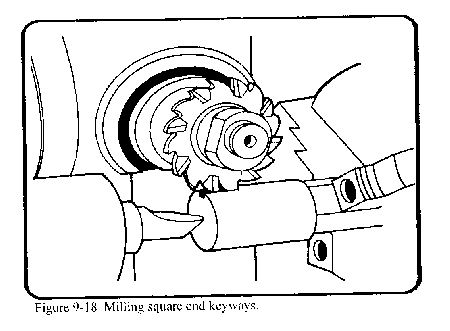
CAUTION Do not over tighten as the pin in the back of the Versa Mil may shear
Speed Selection
If a good flow of coolant is available to the cutter, choose or select speeds near the top of the recommended cutting speeds for the operation being performed, type of cutter used, and material being milled. If milling is to be done dry, then use a speed at the lower end of the recommended cutting speeds.
Centering the Cutter
To center the cutter over the work, first ensure the backlash is removed from the cross slide. Next, start the Versa-Mil and reference the cutter to the side of the work using a paper shim. Zero the cross feed dial; then, raise the Versa--Mil above the top of the work. To determine the distance the cutter must move, add one-half of the diameter of the cutter plus one-half the diameter of the workpiece plus the thickness of the paper shim. Keep in mind some latches only move half the distance shown on the crossfeed dial. After the cutter has been moved over the center of the work lock the cross slide to prevent movement during milling. See Figure 9-19.

Depth of Cut
Start the Versa-Mil and reference the cutter to the top of the workpiece using a paper shim. The depth of cut equals one-half the key thickness plus the chordal height plus the thickness of the paper shim. Tables for chordal height may be found in the new American Machinist's Handbook or Machinery's Handbook. A simple approximate formula for chordal height is key thickness squared, divided by four times the shaft diameter. After the depth of cut is determined and set, tighten the post binding setscrew to prevent the basic unit from moving during machining.
Feed Rate
The rate of feed will vary from 0.001-inch chip thickness per tooth to as much as 0.008 inch per tooth. Determine the feed rate by multiplying the number of teeth on the cutter times the desired chip thickness times the RPM of the cutter. A chip thickness of 0.001 to 0.004 is considered a finishing cut while a chip thickness heavier than 0.004 is considered a roughing cut. Most milling operations involving the Versa-Mil are fed by hand. The operator should attempt to feed the cutter at a consistent rate with each tooth taking the same chip thickness. Power feeding is recommended when long cuts along a shaft or workpiece are necessary. To do this, mount the steady rest on the lathe close to the headstock and clamp the steady rest tightly against the workpiece. Lubricate the headstock center or use a ball bearing type center to allow the headstock spindle to rotate freely while the workpiece remains stationary. If a ball bearing center is not used, maintain low spindle speeds to prevent overheating the work. Feed rates during power feeding are adjusted using of the quick change gearbox on the lead screw.
After the internal diameter of gears or sleeves have been machined to size, keyways or splines may be cut into the work with the Versa-Shaper without removing the work from the lathe chuck (Figure 9-20). This has a major advantage of saving time by not having to change setups.
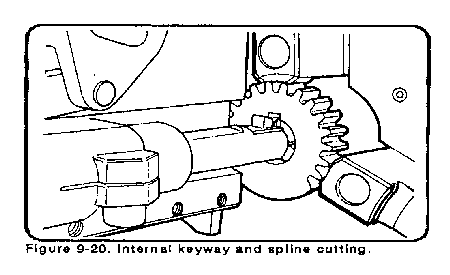
Sizes of Keyways
Each of the standard widths of keyways from 1/8 to 1/2 inch may be cut with one of the standard keyway cutters available with the Versa-Mil. Wider keyways may be cut with one of the standard cutters by cutting the slot to the proper depth and enlarging it by feeding the cutter first to one side and then the other through the use of the cross slide lead screw.
Depth of Cut
Determine the depth of cut by the amount of feed applied to the basic unit lead screw. However, it is necessary to allow the Versa-Shaper to take additional cuts (free cuts) until no further material is removed before taking a measurement. This will assure accurate keyways or splines being machined in the gear or sleeve.
Direction of Feed
Whenever practical, mill keyways and splines by feeding upward with the Versa-Shaper. This will cause the lathe carriage to be held more firmly in contact with the lathe ways and the lathe bed, permitting heavier cuts to be taken.
Clearance
After the Versa-Shaper is set up, run through the entire stroke cycle turning the worm sheave by hand. This will ensure that the cutter clears the work at both ends and does not strike the lathe chuck or encounter any other obstructions.
Plain milling or slabbing (Figure 9-21) is a term applied to many operations such as face milling, milling a hex or square shape, or milling flat surfaces along the side of a workpiece. The process of plain milling normally involves removing large amounts of material with either a shell end mill or side milling cutters to form a flat surface. Work may be held either in the lathe chuck or between centers for plain milling.
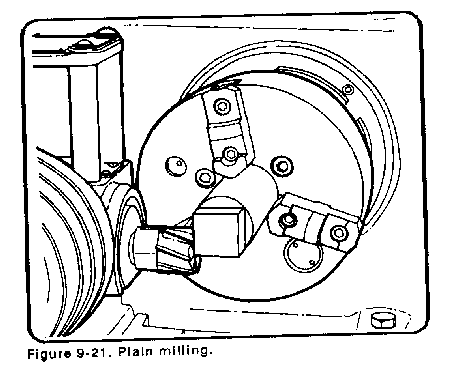
Depth of Cuts
In the case of shell end mills, the depth of cut should not exceed the depth of the teeth or flutes. With side milling cutters, the depth of cut is controlled by the diameter of the cutter. For deep cuts, a staggered tooth, side milling cutter is recommended. Extremely light cuts should be avoided if possible as the cutter tends to slide over the work, heating and dulling the cutter which may result in putting undo pressure on the arbor and carriage causing excessive chatter.
Milling Feeds
The best milling performance is obtained when each tooth of the cutter takes a full chip. When milling steel, for example, the ideal feed is 0.005 inch. Depending on the width of the cutter and machinability of the material, it may be desirable to reduce the depth of cut and increase the rate of feed to maintain chip thickness. Chatter is likely to result when chips are too thin, causing cutter life between grindings to be reduced.
Many drilling and boring operations not ordinarily possible on the lathe are easily performed with the Versa-Mil mounted on the lathe. The Versa-Mil is usually fed by hand using either the either carriage, cross slide, or compound rest. Check the operators manual supplied with the Versa-Mil for information concerning power feeding when drilling.
Off-Center Drilling
Off-center drilling and boring may be performed by positioning the Versa-Mil spindle parallel with the lathe axis and maneuvering the drill by means of the cross slide and the Versa-Mil lead screw. This allows the complete machining of irregularly-shaped items without removing them from the lathe chuck. See Figure 9-22.

Angular Drilling
With the Versa-Mil mounted on the compound rest, holes may be drilled at any angle in relation to the lathe axis by setting the compound rest at the desired angle and feeding the drill into the work with the compound rest lead screw. To use power feeding with the taper attachment, set the taper attachment and Versa-Mil spindle parallel with the hole to be drilled. The work must be held in position to prevent turning when the lathe carriage feed and head stock spindle are engaged. See Figure 9-23.
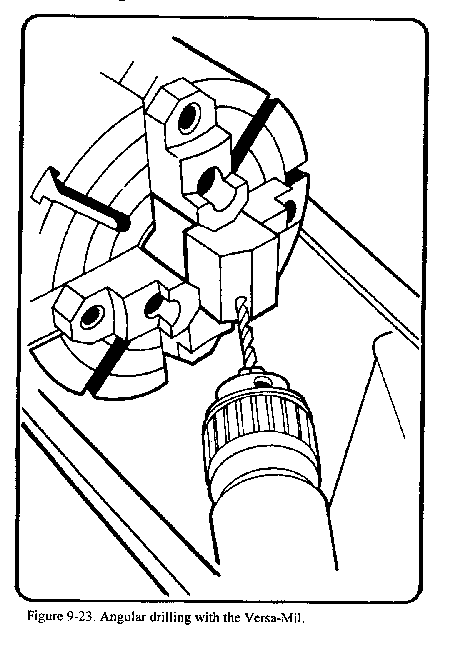
Index Drilling
Stock held in the lathe chuck or between centers can be drilled at regular intervals around the center or perimeter of a workpiece by using the indexing head to position the work. A considerable amount of setup time and effort is saved after positioning the drill for the first hole to be drilled.
Additional Drilling Applications
Drilling with the Versa-Mil attached to a feed table, turret lathe, or vertical boring mill is unique. Special drilling operations with these pieces of equipment are covered in the operator's manual on the Versa-Mil. See Figure 9-24.

Milling Woodruff keyslots (Figure 9-25) in shafts is very similar to milling straight keyways in the basic setup, centering the cutter, and feed rate. The only difference in milling a Woodruff keyslot is that the carriage must be locked down in addition to the cross slide, if cutting from the top of the workpiece, to prevent the basic unit from moving during milling. Cutting a Woodruff keyslot is relatively simple since the proper size cutter has the same diameter and width of the key to be inserted. The work may be held in the lathe chuck or between centers and the cutter may be on an arbor or in a drill chuck. After the cutter has been centered on the work, the cutter is fed directly into the work until the proper depth of cut has been achieved.
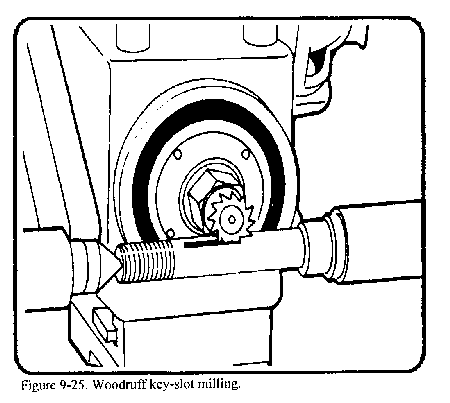
An indexing head comes with the Versa-Mil and is installed on the headstock of the lathe to permit indexing a workpiece. Even though the workpiece is mounted in a conventional manner in the lathe, the headstock spindle should never be allowed to rotate under power with the indexing head attached as this would cause severe damage to the equipment. It is always a good practice to unplug or turn off the main power switch on the lathe in this situation.
Mounting the Workpiece
A workpiece may be supported in the lathe between centers, against the faceplate, or in the lathe chuck. If the work is mounted between centers, a lathe dog is mounted on the work and used to transfer movement from the faceplate to the work.
Indexing the Work
Indexing is the process of controlling the rotational position of a workpiece during machining. The indexing head attaches to the left end of the lathe headstock and locks into the headstock spindle using an expansion adapter. With the indexing head mounted to the lathe, the work will not rotate unless the crank arm of the indexing head is moved. Forty complete turns of the crank arm move the lathe spindle one revolution. The indexing plate contains a series of concentric rings with each ring containing a different number of holes. The workpiece is indexed by moving the crank arm from one hole to another through a calculated pattern of turns and holes. To determine the correct pattern of turns and holes and which ring to use, refer to Chapter 8, Indexing a Workpiece.
Form milling is the process of machining special contours, composed of curves and straight lines or entirely of curves, in a single cut. Gear cutting may be considered form milling by definition; however, the definition is usually restricted to the use of convex, concave, or corner rounding cutters. These form cutters are manufactured in a variety of radii and sizes and may be grouped or ganged together on an arbor to mill intricate shapes. Convex (curved or rounded outward) cutters mill concave (curved or rounded inward) shapes while concave cutters are used to mill convex shapes.
Angle milling is milling flat surfaces which are neither parallel nor perpendicular to the work. Angular milling can be divided into several different types of setups.
Single Angle Milling Cutters
Single angle milling cutters are mounted on an arbor and the arbor is then mounted to the basic unit or universal head. The unit is then squared to the workpiece and the work is milled in a conventional manner. This type of cutter is manufactured in a variety of angles with the most common angles being 45°, 50°, 55°, or 60°.
Dovetail Milling
When cutting dovetails with the Versa-Mil, the workpiece is usually held in the lathe chuck or mounted on a face plate. The tongue or groove of the dovetail is first roughed out using a side milling cutter, after which the angular sides and base are finished with the dovetail cutter. See Figure 9-26.

Compound Rest
Angular milling may also be accomplished on the Versa-Mil by squaring the Versa-Mil on the compound rest and setting the compound rest to the desired angle. With this method of angular milling, the cutter is usually a shell end mill and the work is either held in the lathe chuck or mounted on the faceplate.

Universal Head
Angles may also be milled on a workpiece using the universal head. This head may be tilted to 180° in either direction of center. Complex angles may be machined with the universal head used in conjunction with the compound rest or the tailstock offset method. See Figure 9-28.
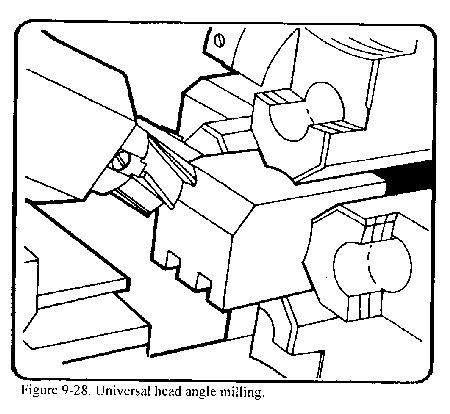
Tailstock Offset
This type of angular milling is accomplished by squaring the unit to the tailstock spindle or faceplate. Normally, a shell end mill is used in this type of milling. Work is mounted between centers and the tailstock is offset to the desired angle for milling. The work may be rotated with the indexing head to mill additional surfaces on the workpiece. See Figure 9-29.
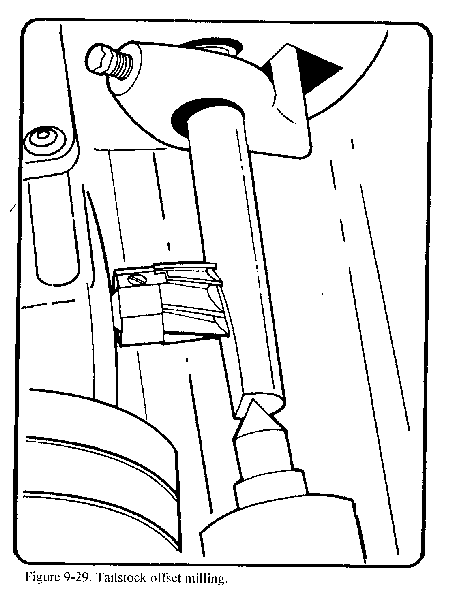
Straddle milling (Figure 9-30) is the machining of two parallel surfaces in a single cut by using two cutters separated by spacers, washers, or shims. Use straddle milling in spline milling or the cutting of squares or hexagons on the end of a cylindrical workpiece. The workpiece is mounted between centers to mill splines on a shaft and mounted in the lathe chuck to mill squares or hexagons. In both cases, the indexing head is used to rotate the work after each cut.
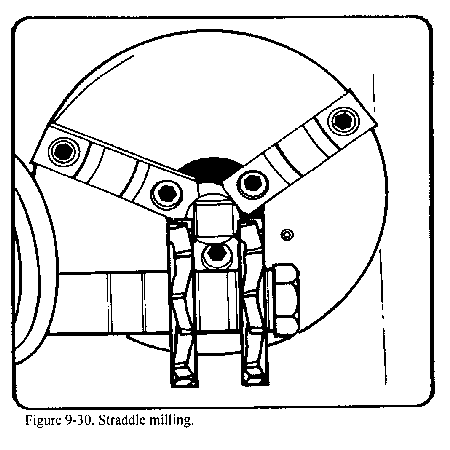
Gang milling differs from straddle milling in that two or more cutters of different diameters or shapes are mounted on the same arbor to mill horizontal surfaces. Cutter combinations in gang milling are virtually unlimited and are determined by the desired shape of the finished product.
Splines are often used instead of keys and keyways to transmit power from the shaft to a hub or gear. Splines are a series of parallel keys and keyways evenly spaced around a shaft or interior of a hub. Splines allow the hub to slide on the shaft either under load or freely. This feature is found in transmissions, automotive mechanisms, and machine tool drives. Manufactured splines are generally cut by bobbing and broaching; however, this discussion will be limited to field expedient methods. Standard splines on shafts and spline fittings are cut with 4, 6, 10, or 16 splines.
The dimensions depend upon the class of fit and the shaft diameter. The class of fit may be permanent, sliding fit not under load, and sliding fit under load. Table 8-8 in Appendix A lists the standard dimensions for the different classes of fits. Shafts may be milled several different ways.
The most common way is to use two side milling cutters separated by spacers, with the width of the spacers equal to the width of the spline. The splines are cut by straddle milling each spline to the proper depth and indexing around the shaft for each spline. A narrow plain milling cutter is used to mill the spaces between the splines to the proper depth. It may be necessary to make several passes to mill the groove uniformly around the shaft. A formed cutting tool or cutter may also be used for this operation.
After a hub or gear has been drilled and bored to the finished internal minor diameter, internal splines may be cut into the hub or gear by using the Versa-Shaper (Figure 9-31). The indexing head provides the means to locate each spline to be cut. For this operation, the milling is continued until the desired class of fit is obtained. For field expedience, it is best to machine the mating parts to match if possible.

Slotting with the Versa-Mil (Figure 9-32) covers a wide variety of operations from milling long wide slots in material to cutting curved or thin slots. Workpieces may be mounted in the lathe chuck or between centers for slotting operation.

Longitudinal Slots
Longitudinal slots along a shaft or other large piece may be cut in the material in the same manner as milling keyways with end mills. It is often desirable to use a cutter smaller than the width of the slot. The reason for this is, when the cutter is as wide as the slot, one side of the cutter is climb milling while the opposite side of the milling cutter is performing conventional milling. This causes a difference in the finish between the two sides of the slot. A roughing out of the slot should be made first, followed by a finishing cut down one side of the slot and returning on the other side.
Narrow Slots
For narrow slots, use slitting saws rather than end milling cutters. When using slitting saws, reduce speeds and feeds to extend the life of the cutter.
Fly cutting (Figure 9-33), also called single-point milling, is one of the most versatile milling operations available to the machinist. Fly cutting is done with a single-point cutting tool, like the lathe or shaper cutting tool, held in a fly cutting arbor. Formed cutters are not always available and there are times when special form cutters are needed only for a very limited number of parts or operations; therefore, it is moreeconomical to grind the desired form on a lathe cutter bit rather than order a special form cutter. The fly cutter is used to great extent in the reshaping of repaired gears because the tool bit can be ground to the shape of gear teeth available. Fly cutting can also be used in cutting standard and special forms of splines.

Plain or Face Milling of Soft Nonferrous Metals
Plain or face milling of soft nonferrous metals such as aluminum, with a fly cutter produces a high quality finish. Boring holes with a fly cutter is generally not desirable because of the difficulty in positioning the cutter and controlling the diameter. The short arbor allows boring of only very shallow holes.
Gear Cutting
A variety of gears, pinions, and sprockets can be fabricated on the lathe using the Versa-Mil. By referring to various texts and references for detailed data and instructions on gears and gear cutting, the operator can develop different methods of mounting the Versa-Mil to the lathe to perform gear cutting. The basic unit and the indexing head are the two basic elements needed to cut gears. When large diameter gears need to be cut, the universal head is used to mill the side of the gear.
Spur gears are the most common type of gear used in the field and the correct cutter to use for this type of gear is determined by the pitch of the teeth and the number of teeth required. Standard cutter catalogs supply the data necessary to select the correct cutter.
Gear Cutting with the Basic Unit and an Involute Gear Cutter
In this setup, Figure 9-34, the gear blank is first turned to the correct diameter using a mandrel mounted between centers. The blank should remain on the mandrel after turning. The lathe dog should be wedged against the faceplate to eliminate backlash and the indexing head mounted to the lathe spindle to position the individual teeth. The basic unit is mounted on the compound rest with the faceplate parallel to the lathe center and an arbor with an involute gear cutter, stamped with the correct pitch and number of teeth, is installed in the basic unit. After the cutter is positioned, lock down the cross feed by tightening the gibs. When the correct depth is reached, tighten the post locking screw on the basic unit. The cutter is then fed into the blank by hand using the lathe carriage wheel.

Gear Cutting with the Basic Unit and a Fly Cutter
When an involute gear cutter is not available or delay in obtaining one is too great, a flycutter is used. The only difference is that a fly cutter with a 5/16-inch square tool bit, ground to the correct shape, is used instead of an involute gear cutter. See Figure 9-35.

Gear Cutting with a Universal Head
Used this setup with either a fly cutter or an involute gear cutter on gear blanks larger than 8 inches in diameter. See Figure 9-36.
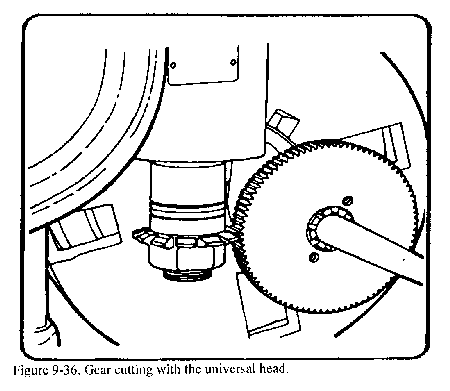
Wheel dressing (Figure 9-37) with the diamond dresser is a must for accurate precision grinding. Dress wheels before starting any grinding job and again prior to the finishing cut. The diamond dresser is the most efficient type of wheel dresser for truing wheels used in precision grinding. The diamond point is the only usable part of the diamond and must be inspected frequently for wear. Rotate the diamond slightly in the holder between dressings to keep the point sharp. A dull diamond will press the wheel cuttings into the bonded ores of the wheel, increasing the wheel's hardness. When truing the wheel, the diamond should be centered on the wheel and slanted between 5° and 15° in the direction of wheel rotation to prevent chatter and gouging.
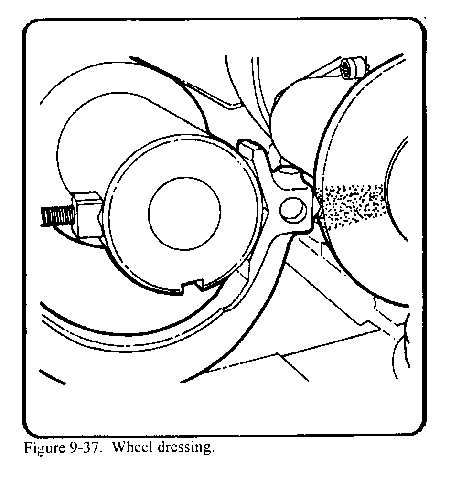
The grinding wheel should rotate at or slightly less than operating speed when truing or dressing, never at a higher speed After truing, slightly round the edges of the wheel with an oilstone to prevent the wheel from chipping, unless the work requires sharp corners. Start the dressing process at the highest spot on the wheel, normally the center, and feed at a uniform rate with a 0.002 inch depth of cut per pass. Too slow a feed will glaze the wheel while too fast a feed rate will leave dresser marks on the wheel.
A wide range of grinding is made available to the machinist by using the Versa-Mil and the different grinding heads supplied with the unit. Refer to references published by the leading abrasive manufacturers when selecting the proper wheel for the job being performed. For maximum metal removal and minimum wheel wear, surface speeds of the grinding wheel should be near the highest allowable speed for the wheel size. Light cuts at full speed will remove metal faster than deep cuts at slow speeds. In general, rough cuts average 0.002 inch per pass, while finishing cuts average 0.0005 inch. The spindle rotation should be selected to throw wheel and metal debris away from the operator. When movement of the work is required during grinding, the work and the wheel should rotate in the same direction. This allows the wheel and work to move in opposite directions at the point of contact. The precision grinding may be done either wet or dry.
Before grinding work between centers takes place the centers should be ground true (Figure 9-38). With the center mounted in the lathe headstock, mount the Versa-Mil on the compound rest and set the compound rest at one-half the included angle of the center. Grind the center by feeding the compound lead screw by hand at a uniform rate of feed.
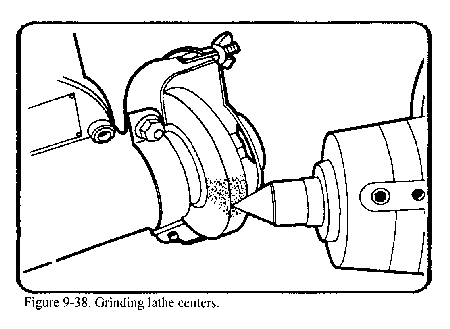
The lengths and diameters of shafts ground on a lathe are determined by the lathe swing and the distance between the lathe centers. Mount the Versa-Mil on the compound rest with the face of the basic unit parallel to the work surface. In cylindrical grinding (Figure 9-39), the work rotates slowly while the wheel rotates close to the highest allowable speed. The wheel should never leave the work at either end of the cut in order to produce a smooth surface free of wheel marks. Direct the spark pattern downward onto a dampened cloth to prevent very small particles of material from getting into and destroying machined surfaces. A spark pattern directed downward and away from the operator indicates the wheel is too low on the work, while a spark pattern that is directed downward and toward the operator indicates the wheel is too high on the work. Conical grinding can be accomplished with either the taper attachment or by the tailstock offset method.

Holes and bores as deep as 18 inches may be internally ground using the Versa-Mil. The diameter of the hole may be any size larger than 3/4 inch. Either the internal grinder with the taper spindle or the deep-hole grinder may be used, depending on the hole dimensions. Internal grinding differs from external grinding basically in one area. The surface contact between the work and the wheel is much greater in internal grinding, causing the wheel to load and glaze much more quickly. This loading or glazing will cause unnecessary vibration and produce a poor surface finish. A coarser wheel grain structure, which provides better chip clearance, or a softer wheel that will break down more easily, should be used for internal grinding. While grinding, the wheel should clear the end of the work at least one half the wheel thickness but not more than two thirds. If the wheel is allowed to clear the end of the work entirely, a bell-shaped effect will be produced.
Tapered Spindle Grinder
For shallow and small diameter holes up to 6 inches in depth, use the tapered spindle internal grinder. Tapers may also be ground on the work by using either the taper attachment or the compound rest. See Figure 9-40.
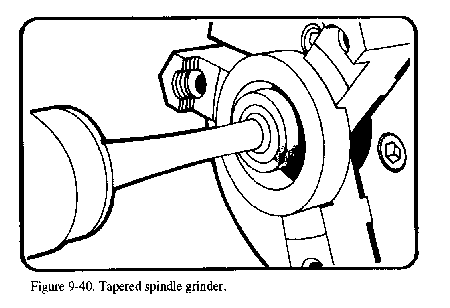
Deep Hole Grinder
The deep-hole grinder with the extended housing offers a rigid precision grinder for holes as deep as 18 inches. Tapers may also be ground with the deep-hole grinder. See Figure 9-41.

Versa Grinder Head
The Versa-Mil external grinder with the wheel guard removed may be used for internal grinding of large bored pieces if a considerable amount of stock must be removed and the hole depth does not exceed the unit clearance. This setup permits the operator to grind internally, externally, and face in one setup, assuring a true relation between the three different surfaces. See Figure 9-42.
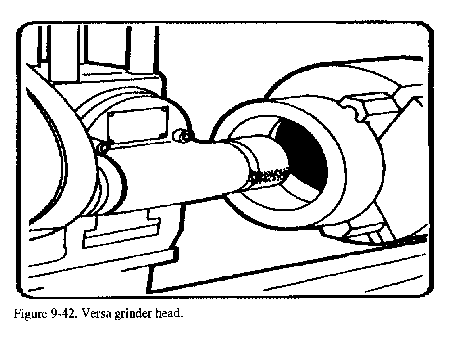
The Versa-Mil mounted on the compound rest of a lathe will duplicate the full range of tool and cutter grinding offered by conventional tool grinders. For successful results, the lathe should be in excellent operating condition and preferably small in size to permit the close setting of feeds and angles. Versa-Mil spindles use precision, spring-loaded duplex bearings to eliminate play in the grinding wheel for successful tool grinding. The Versa-Mil tool rest is solidly constructed to provide rigid support with a tip that is designed for smooth, solid contact under the teeth or flutes of the tool being ground. The operator familiar with tool grinding and the use of the Versa-Mil soon develops methods for grinding the various types and forms of cutters. Tool grinding cannot be completely covered in this manual, and it is suggested that reference material covering tool grinding be consulted for complete detailed instructions.
Selection of Grinding Wheels
Grinding wheels should be in the medium grit range for tool and cutter grinding. The shape of the cutting tool will determine which wheel design to use. Abrasive manufacturers' catalogs should be referred to for proper wheel selection.
Depth of Cut
Light traversed cuts should be used to avoid overheating and burning the cutting edge of the tool. Dry grinding is recommended for sharpening high speed steel because coolant removes heat from the cutting edge too quickly causing cracking.
Direction of Wheel Rotation
It is generally safer to have the wheel rotate off and away from the tool cutting edge. This allows the tooth rest to position the tooth and prevent the cutter from turning. This method, however, has some drawbacks, in that the heat from grinding is directed toward the tool cutting edge and leaves a burr which must be removed with an oilstone.
The efficiency of a cutter is determined by the sharpness of its cutting edge. Therefore, it is important to sharpen a cutter at the first sign of dullness. A dull cutter not only produces a poorly finished surface, but if used continuously, the cutter will need excessive sharpening to restore it to its original efficiency.
Grinding Cutters Cylindrically
Certain types of cutting tools, such as reamers and plain milling cutters, are ground cylindrically to remove warpage from heat treating, to remove nicks, to obtain a specific diameter, or to produce a cutting edge with a slight clearance. When grinding tools or cutters, the work rotates in the opposite direction from that used in conventional grinding. This allows movement in the same direction at the point of contact. Mount the cutter so that the heel of the tooth makes contact with the grinding wheel first, allowing the heel of the tooth to be ground slightly lower than the cutting edge. This clearance will vary slightly depending on the rigidity of the tool being ground and the job setup. The tool to be ground can be held in one of three ways: between centers, on a mandrel, or on a short arbor mounted in the lathe headstock spindle. There are actually two methods of sharpening the cutting edges of individual teeth or flutes found on cutters.
Down Method
In this method, the rotation of the wheel is from the body of the tooth off and away from the cutting edge. The direction of wheel rotation holds the cutter on the tooth but will raise a burr on the cutting edge, which must be removed by stoning. This method has a tendency to draw temper from the metal. See Figure 9-43.
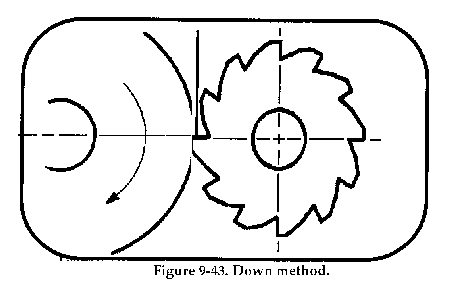
Up Method
In this method, the wheel rotation is from the cutting edge towards the body of the tooth. With this method, there is less danger of burning the tooth. However, the operator must ensure that the cutter is held firmly against the tool rest. If the cutter turns during grinding, the cutter will be ruined.
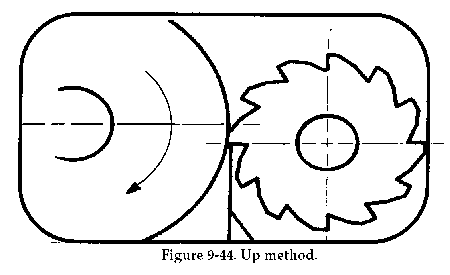
Cutting Tool Clearance
Correct clearance on the cutting edge of any tool is essential for heat distribution, resistance to wear, and cutting efficiency. Not enough clearance will cause the teeth on the cutter to drag, producing heat caused by friction, and slow cutting. Too much clearance produces chatter and dulls the teeth rapidly. Primary clearance angles are determined by the type of material the cutter will be used on. Secondary clearance angles are usually 3° to 5° more than primary clearance angles. This produces a strong tooth that provides easy control over the width of the cutting land. The width of the land depends on the diameter of the cutter and varies between 1/64 inch to 1/16 inch. When the width of the land becomes too wide after several sharpenings, the secondary clearance angle must be ground to restore the land to its original width.
Clearance angles are produced by positioning the wheel, cutter, and tooth rest in different locations. When using the Versa-Mil, it is easier to reposition the wheel by raising or lowering the basic unit. To determine the distance in thousands of an inch, multiply the desired clearance angle by the diameter of the cutter times the constant 0.0088. The constant 0.0088 is the decimal equivalent of the distance moved 1° on the circumference of a l-inch-diameter circle.
EXAMPLE: Using the following formula clearance angle x cutter diameter x 0.0088, a clearance angle of 7° on a 1 1/2-inch-diameter cutter would be 7 x 1.5 x 0.0088, or a movement of 0.0924 of an inch.
Grinding Form Cutters
Formed or eccentricity relieved cutters (such as gear cutters) and concave and convex cutters cannot be sharpened in the same manner as profile cutters. Form cutters have a definite shape that must be retained, even after several sharpenings. To retain this shape, only the face of the cutter is ground. Increasing or decreasing the rake on these cutters alters the final shape of the cutter, so care must be taken to ensure that the rake remains at the original angle. The indexing head may be used to assure even spacing of the teeth faces.
The Versa-Mil with the universal head will enable a lathe to mill threads to full depth and complete profile in a single pass (Figure 9-46). Milling threads saves time and reduces the chance for error over single pointing. USS threads may be cut with standard 60° included angle cutters.

Acme and special form threads are cut with cutters designed for the pitch diameter required. The Versa-Mil will cut internal, external, right-handed, or left-handed threads. Square threads can be cut with an end mill mounted in either the basic or the milling and drilling head.
Lathe Preparation
Thread milling speeds and feeds are approximately the same as those used for keyway milling and slotting. The lathe spindle speeds needed for thread milling are generally lower than those available on standard lathes. It is usually necessary to use a reduction unit mounted to the lathe to obtain the required lathe spindle speed. Large diameter workpieces may require speeds as low as 1/2 or 1/3 RPM. Other than lathe spindle reduction, no other modification of the lathe is needed for thread milling. The quick change gearbox and lead screw are set the same as for single point threading. The indexing head may be mounted to the lathe and used to rotate the lathe spindle when a reduction unit is not available.
Mounting the Versa-Mil
Even though the cutter is at or below the centerline of the work when the basic unit is mounted on the compound rest, it is advisable to mount the unit directly to the cross slide for rigidity.
Supporting the Work
Work of sufficient diameter and rigidity may be supported easily between centers. For long or small diameter work, a steady rest or follower should be used to prevent the work from bending away from the cutter thereby reducing the depth of cut.
Depth of Cut
For external threads, the cutter is fed into the work with the cross feed lead screw. For internal threads, the cutter is fed into the work with the basic unit lead screw. Because thread milling with the Versa-Mil is a one-pass operation, total depth of cut is calculated and set before cutting the thread.
Cutter Rotation
Consideration should be taken when mounting the cutter and selecting the spindle rotation. Conventional milling should be used to put pressure downward onto the carriage. A key may have to be inserted in the arbor to prevent the cutter from loosening the spindle nut.
Accessibility to Work
Because the universal head spindle may be operated in either direction and mounted on either side of the basic unit, threads may be milled at either end of the work and very close to shoulders and flanges.
Helix Angles
The graduations on the basic unit faceplate and the mounting plate of the universal head are used to set the approximate helix angle. Refer to the Versa-Mil operator's manual for helix angles of different threads.
Thread Milling Cutters
Cutters as small as 2 3/4-inches in diameter may be used with the universal head for external thread milling. The cutter diameter for internal threads is governed by the internal diameter of the work. Standard 60° included angle cutters may be modified for use for American Standard Threads by grinding a flat on the point. The width of the flat equals 1/8 the thread pitch and must have relief clearance the same as other cutting tools.
Source: http://faculty.ksu.edu.sa/hossainy/Book1/Chapter%209.doc
Web site to visit: http://faculty.ksu.edu.sa
Author of the text: indicated on the source document of the above text
If you are the author of the text above and you not agree to share your knowledge for teaching, research, scholarship (for fair use as indicated in the United States copyrigh low) please send us an e-mail and we will remove your text quickly. Fair use is a limitation and exception to the exclusive right granted by copyright law to the author of a creative work. In United States copyright law, fair use is a doctrine that permits limited use of copyrighted material without acquiring permission from the rights holders. Examples of fair use include commentary, search engines, criticism, news reporting, research, teaching, library archiving and scholarship. It provides for the legal, unlicensed citation or incorporation of copyrighted material in another author's work under a four-factor balancing test. (source: http://en.wikipedia.org/wiki/Fair_use)
The information of medicine and health contained in the site are of a general nature and purpose which is purely informative and for this reason may not replace in any case, the council of a doctor or a qualified entity legally to the profession.
The texts are the property of their respective authors and we thank them for giving us the opportunity to share for free to students, teachers and users of the Web their texts will used only for illustrative educational and scientific purposes only.
All the information in our site are given for nonprofit educational purposes